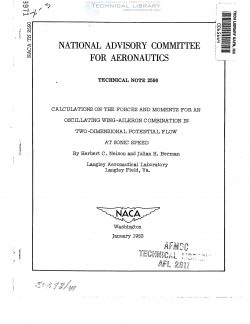naca-tn-2590
- Version
- 146 Downloads
- 1.23 MB File Size
- 1 File Count
- January 9, 2017 Create Date
- January 9, 2017 Last Updated
National Advisory Committee for Aeronautics, Technical Notes - Calculations on the Forces and Moments for an Oscillating Wing Aileron Combination in Two Dimensional Potential Flow at Sonic Speed

The linearized theory for compressible unsteady flow is’used, as
suggested in recent contributions to the subject, to obtain the velocity
potential and the lift and moment for a thin, harmonically oscillating,
two-dimensional wing-aileron combination moving at sonic speed. The
velocity potential is derived by considering the sonic case as the limit
of the linearized supersonic theory. From the velocity potential
explicit expressions for the lift and moment are developed for vertical
translation and pitching of the wing and rotation of the aileron.
The paper provides extensive tables of numerical values for the coefficients
contained in the expressions for lift and moment, for various values of
the reduced frequency k (O<< k‘; 3.5) and aileron hinge position (from
10 to 90 percent of the wing chord). The sonic results are compared and
found to be consistent with previously obtained subsonic and supersonic
results. Several figures are presented showing the variation of lift
and moment with reduced frequency and mach number and the influenCe of
Mach number on some cases of bending-torsion flutter.
Instability investigations for high-speed aircraft often require a
knowledge of the air forces and moments that act on an oscillating wing
moving at high speed. For subsonic and supersonic speeds the main source
of theoretical information has been the solution of the‘linearized dif-
ferential equation for compressible flow. For sonic or near—sonic speed,
however, the linearized theory has been generally assumed inapplicable,
since it does not allow for thickness effects, shocks, and strong dis-
turbances. As is well known, it predicts infinite forces on a non-
oscillating, thin, unswept wing moving at sonic speed.
Important differences exist, however, between the steady and
unsteady cases. By a.discussion of the order of magnitude of the terms
of the general nonlinear differential equation for compressible flow,
reference 1 shows that for unsteady two-dimensional flow at sonic speed
this equation is essentially linear and in linear form leads to phys—
ically plausible results for the forces on a thin oscillating wing,
provided the frequency of oscillation is sufficiently large.
| File | Action |
|---|---|
| naca-tn-2590 Calculations on the Forces and Moments for an Oscillating Wing Aileron Combination in Two Dimensional Potential Flow at.pdf | Download |

Comment On This Post